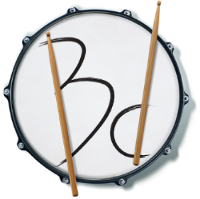The Ticking of Time: Common Timekeeping Cymbal Patterns
When learning to play a basic drum groove, you likely started out with something along the lines of hitting the bass drum on beats 1 and 3, hitting the snare drum on beats 2 and 4, and keeping a steady 8th note rhythm on the hihats. Thousands upon thousands of songs use either that exact groove or something similar. But the overall feel of the groove can be heavily influenced by the timekeeping pattern played on the hihats (or ride cymbal).
Let’s explore some of the most common cymbal patterns and hear how they can affect a groove’s feel. We’ll first apply each cymbal pattern over a very basic groove, and then over something that’s got some more depth to it.
8th Notes
Arguably the most common of the bunch, playing 8th notes on the hihats or ride cymbal is a standard approach. Most popular songs primarily make use of rhythms on the 8th and 16th note grids, which works out nicely for the purposes of groove building. Steady 8th notes strike a balance between consistency and being easy to follow without feeling too busy. Here, they are written over a basic kick and snare pattern (kick on 1 and 3, snare on 2 and 4).
Quarter Notes
For a wider feel, playing steady quarter notes over a groove provides some breathing room. However, just because you’re playing fewer notes doesn’t mean that quarter notes are necessarily easier. The less regularly your dominant hand plays, the more exposed your kick and snare become, especially if there are 16th notes at work between them (which we’ll encounter further down). But sometimes a wider feel is exactly what’s needed for a song!
8th Note Upbeats
If you nudge those quarter notes off by half of a beat, you’d end up playing on the 8th note upbeats, or just the ‘&’ of each beat. This pattern is very common among dance grooves (think “boots and cats and boots and cats and...”) and helps to create a sort of counterpoint against the kick and snare underneath. The bigger challenge here is resisting the urge to strike directly on the beats with your dominant hand, which is easier said than done at first!
16th Notes
Further dividing each beat into smaller parts results in yet another distinct feel. Steady 16th notes (played with only one hand) on the hihats works really well with music at slightly slower tempos, where they’re more easily accessible. Dynamics become a bit more important here since the pattern is quite busy compared to the others. If your cymbal becomes too loud, the feel will begin to constrict. Playing with a light touch helps a lot with getting the 16th notes to seemingly skim over the surface of the groove. They ultimately behave as a texture in addition to being a timekeeping element.
Galloping Patterns
It’s also possible to use timekeeping patterns that aren’t just a consistent pulse. Using the 16th note grid, there are two common “galloping” rhythms, which entail playing only three 16th notes within each beat. One of them consists of playing the first three 16th notes (1 e & -, 2 e & -, 3 e & -, 4 e & -), and the other skips over the ‘e’ of each beat (1 - & a, 2 - & a, 3 - & a, 4 - & a). These patterns find some middle ground between steady 8th notes and steady 16th notes. The first of the two galloping patterns feels more resolute, while the other creates more forward momentum.
3-16th Gallop A
3-16th Gallop B
Changing the Groove
To get a better sense of how much a timekeeping pattern can really affect an underlying groove, let’s try a more involved kick and snare sequence. Now, we’ll have a few 16th note rhythms on the kick, and we’ll hit the snare drum on the ‘a’ of beat 3 instead of directly on beat 4 (so one 16th note earlier than usual). This new kick and snare sequence creates very different interactions between itself and whatever cymbal pattern sits on top. Take a look at each of these combinations written out below. And be sure to check out the video at the bottom to hear what they all sound like!
8th Notes
Quarter Notes
8th Note Upbeats
16th Notes
Galloping Patterns
3-16th Gallop A
3-16th Gallop B
To master each of these timekeeping patterns, try creating a kick and snare combination of your own and run it through each cymbal variation. You may also begin to notice these patterns more and more in the music you listen to. If a groove feels a little stiff or stale, an alternate timekeeping pattern might just be the solution to polishing an idea!












